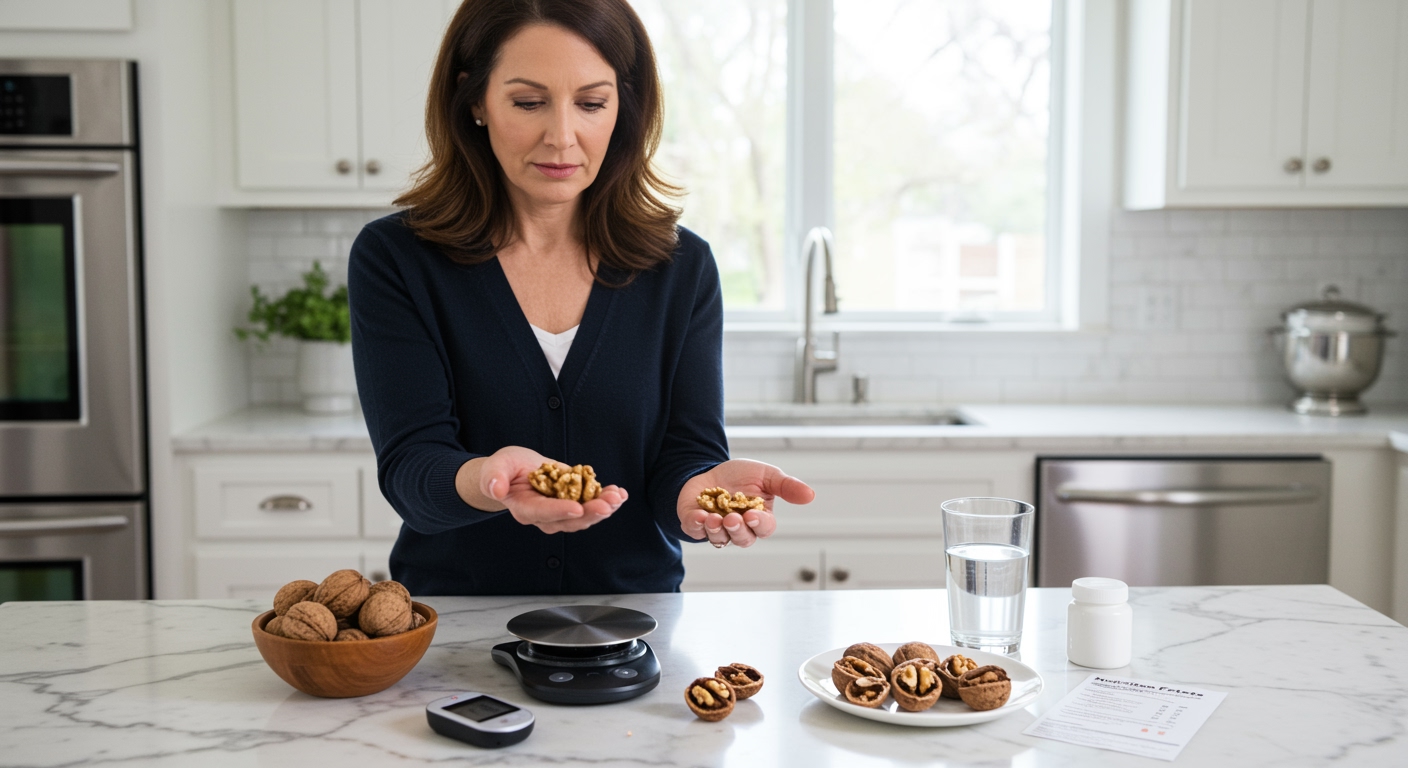✪ Key Takeaway: Walnuts are excellent for diabetes as they have a low glycemic index and help improve blood sugar control when eaten in proper portions.
Introduction
You reach for a handful of walnuts and suddenly wonder if you are making a mistake with your blood sugar.
Many people with diabetes feel confused about which nuts are safe to eat because they worry about hidden carbs and unexpected blood sugar spikes.
Hi, I am Abdur, your nutrition coach and today I am going to explain exactly how walnuts affect your blood sugar and why they might be one of the best snacks for diabetes management.
Do Walnuts Raise Blood Sugar Levels?
Walnuts have a glycemic index of only 15, which puts them in the low glycemic category that barely affects blood sugar.
This low number means your blood glucose will rise very slowly and minimally after eating walnuts compared to high-carb foods like bread or rice.
The glycemic load of a typical 1-ounce serving of walnuts is even more impressive at just 1, making them practically neutral for blood sugar control.
Walnuts contain only about 4 grams of carbohydrates per ounce, with 2 grams coming from fiber that does not impact blood glucose levels.
The high fiber and healthy fat content in walnuts actually slow down digestion and help prevent rapid blood sugar spikes that diabetics need to avoid.
✪ Pro Tip: Test your blood sugar 2 hours after eating walnuts to see your individual response and adjust portions accordingly.
What Makes Walnuts Diabetes-Friendly?
The unique nutritional profile of walnuts makes them particularly beneficial for people managing diabetes and blood sugar concerns.
Walnuts are packed with omega-3 fatty acids, specifically alpha-linolenic acid, which helps reduce inflammation that often accompanies diabetes.
These healthy fats also improve insulin sensitivity, meaning your body can use insulin more effectively to manage blood glucose levels.
The protein content in walnuts helps stabilize blood sugar by slowing the absorption of any carbohydrates you eat alongside them.
Research shows that people who eat walnuts regularly have lower fasting glucose levels and better overall glycemic control compared to those who avoid nuts.
The magnesium in walnuts plays a crucial role in glucose metabolism and helps your cells respond better to insulin signals.
✪ Fact: Studies show eating 2 ounces of walnuts daily can reduce diabetes risk by up to 24% in healthy adults.
How Many Walnuts Can Diabetics Eat Safely?
The ideal serving size for diabetics is 1 ounce of walnuts, which equals about 14 walnut halves or roughly a small handful.
This portion provides approximately 185 calories, 18 grams of healthy fats, and only 4 grams of carbohydrates that will not significantly impact blood sugar.
You can safely eat this amount once or twice daily as part of a balanced diabetes meal plan without worrying about blood glucose spikes.
Some people with well-controlled diabetes can handle up to 2 ounces daily, but this depends on your individual carbohydrate tolerance and overall diet.
The key is to replace other snacks with walnuts rather than adding them on top of your current food intake to avoid excess calories.
Always count the carbohydrates from walnuts in your daily total, even though the amount is small and mostly comes from fiber.
✪ Note: Measure your walnut portions with a kitchen scale initially to learn what 1 ounce looks like visually.
When Should Diabetics Eat Walnuts For Best Results?
The timing of when you eat walnuts can make a significant difference in how they affect your blood sugar and overall diabetes management.
Eating walnuts before meals can help slow down the absorption of carbohydrates from your main dish, leading to better post-meal blood glucose control.
Having a small portion of walnuts as a mid-morning or afternoon snack helps prevent blood sugar dips that can lead to overeating later.
Avoid eating walnuts late at night because the calories and fats can interfere with your body’s natural overnight glucose regulation processes.
Pairing walnuts with low-carb vegetables or a small amount of protein creates an even more blood sugar-stable snack combination.
If you take diabetes medications, eating walnuts consistently at the same times daily helps you predict and manage your blood glucose patterns more effectively.
✪ Pro Tip: Keep pre-portioned walnut servings in small containers to avoid mindless overeating during busy days.
Are There Any Risks For Diabetics Eating Walnuts?
While walnuts are generally safe for diabetics, there are a few important considerations to keep in mind for optimal health outcomes.
The main concern is portion control because walnuts are calorie-dense, and excess calories can lead to weight gain that worsens insulin resistance.
Some people may experience digestive issues like bloating or stomach upset when they first start eating walnuts, especially if they consume too many too quickly.
Walnuts can interact with certain blood-thinning medications due to their omega-3 content, so consult your doctor if you take anticoagulants.
Always choose raw or dry-roasted walnuts without added salt, sugar, or oils that can negatively impact blood sugar and blood pressure.
People with tree nut allergies obviously cannot eat walnuts, and cross-contamination in processing facilities can be a concern for those with severe allergies.
Store walnuts properly in the refrigerator or freezer because their high fat content makes them prone to rancidity that can cause inflammation.
✪ Fact: Rancid walnuts taste bitter and can increase oxidative stress that damages blood vessels in diabetics.
The Bottom Line
Walnuts are not only safe for diabetics but can actually help improve blood sugar control when eaten in appropriate portions as part of a balanced diet.
The best foods for diabetes are often the simplest ones that nature provides without any processing or added ingredients.
I would love to hear about your experience with walnuts and diabetes management, so please share your questions, success stories, or concerns in the comments below.
References
At NutritionCrown, we use quality and credible sources to ensure our content is accurate and trustworthy. Below are the sources referenced in creating this article:





